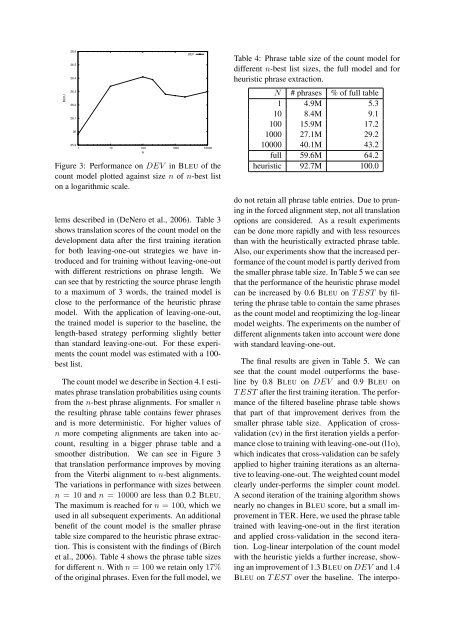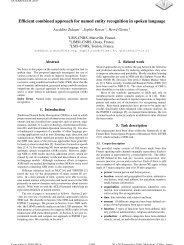Training Phrase Translation Models with Leaving-One-Out - Quaero
Training Phrase Translation Models with Leaving-One-Out - Quaero
Training Phrase Translation Models with Leaving-One-Out - Quaero
Create successful ePaper yourself
Turn your PDF publications into a flip-book with our unique Google optimized e-Paper software.
Figure 3: Performance on DEV in BLEU of thecount model plotted against size n of n-best liston a logarithmic scale.lems described in (DeNero et al., 2006). Table 3shows translation scores of the count model on thedevelopment data after the first training iterationfor both leaving-one-out strategies we have introducedand for training <strong>with</strong>out leaving-one-out<strong>with</strong> different restrictions on phrase length. Wecan see that by restricting the source phrase lengthto a maximum of 3 words, the trained model isclose to the performance of the heuristic phrasemodel. With the application of leaving-one-out,the trained model is superior to the baseline, thelength-based strategy performing slightly betterthan standard leaving-one-out. For these experimentsthe count model was estimated <strong>with</strong> a 100-best list.The count model we describe in Section 4.1 estimatesphrase translation probabilities using countsfrom the n-best phrase alignments. For smaller nthe resulting phrase table contains fewer phrasesand is more deterministic. For higher values ofn more competing alignments are taken into account,resulting in a bigger phrase table and asmoother distribution. We can see in Figure 3that translation performance improves by movingfrom the Viterbi alignment to n-best alignments.The variations in performance <strong>with</strong> sizes betweenn = 10 and n = 10000 are less than 0.2 BLEU.The maximum is reached for n = 100, which weused in all subsequent experiments. An additionalbenefit of the count model is the smaller phrasetable size compared to the heuristic phrase extraction.This is consistent <strong>with</strong> the findings of (Birchet al., 2006). Table 4 shows the phrase table sizesfor different n. With n = 100 we retain only 17%of the original phrases. Even for the full model, weTable 4: <strong>Phrase</strong> table size of the count model fordifferent n-best list sizes, the full model and forheuristic phrase extraction.N # phrases % of full table1 4.9M 5.310 8.4M 9.1100 15.9M 17.21000 27.1M 29.210000 40.1M 43.2full 59.6M 64.2heuristic 92.7M 100.0do not retain all phrase table entries. Due to pruningin the forced alignment step, not all translationoptions are considered. As a result experimentscan be done more rapidly and <strong>with</strong> less resourcesthan <strong>with</strong> the heuristically extracted phrase table.Also, our experiments show that the increased performanceof the count model is partly derived fromthe smaller phrase table size. In Table 5 we can seethat the performance of the heuristic phrase modelcan be increased by 0.6 BLEU on T EST by filteringthe phrase table to contain the same phrasesas the count model and reoptimizing the log-linearmodel weights. The experiments on the number ofdifferent alignments taken into account were done<strong>with</strong> standard leaving-one-out.The final results are given in Table 5. We cansee that the count model outperforms the baselineby 0.8 BLEU on DEV and 0.9 BLEU onT EST after the first training iteration. The performanceof the filtered baseline phrase table showsthat part of that improvement derives from thesmaller phrase table size. Application of crossvalidation(cv) in the first iteration yields a performanceclose to training <strong>with</strong> leaving-one-out (l1o),which indicates that cross-validation can be safelyapplied to higher training iterations as an alternativeto leaving-one-out. The weighted count modelclearly under-performs the simpler count model.A second iteration of the training algorithm showsnearly no changes in BLEU score, but a small improvementin TER. Here, we used the phrase tabletrained <strong>with</strong> leaving-one-out in the first iterationand applied cross-validation in the second iteration.Log-linear interpolation of the count model<strong>with</strong> the heuristic yields a further increase, showingan improvement of 1.3 BLEU on DEV and 1.4BLEU on T EST over the baseline. The interpo-



